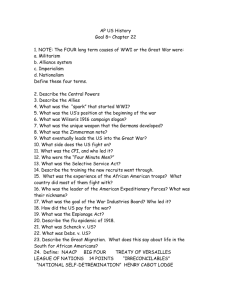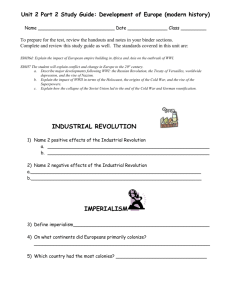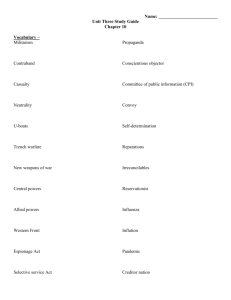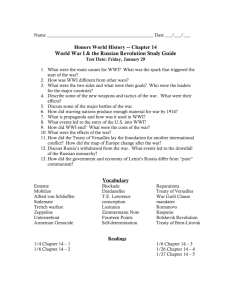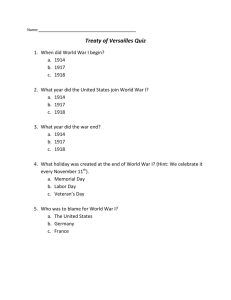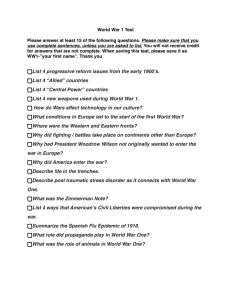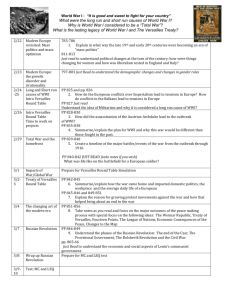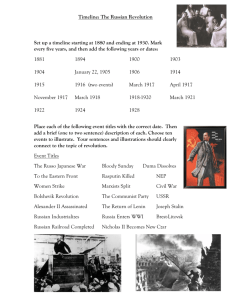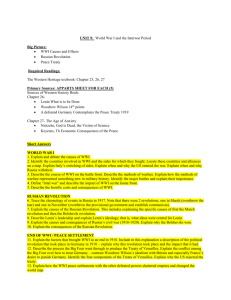Unit 8: WWI & the Russian Revolution
advertisement
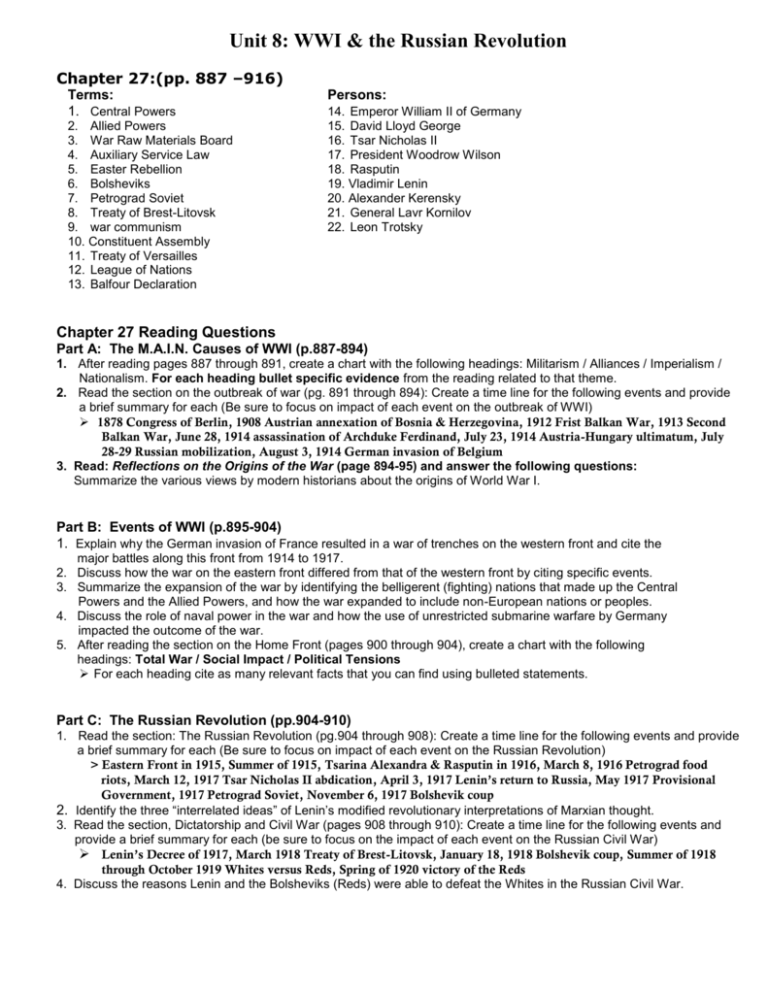
Unit 8: WWI & the Russian Revolution Chapter 27:(pp. 887 –916) Terms: 1. Central Powers 2. Allied Powers 3. War Raw Materials Board 4. Auxiliary Service Law 5. Easter Rebellion 6. Bolsheviks 7. Petrograd Soviet 8. Treaty of Brest-Litovsk 9. war communism 10. Constituent Assembly 11. Treaty of Versailles 12. League of Nations 13. Balfour Declaration Persons: 14. Emperor William II of Germany 15. David Lloyd George 16. Tsar Nicholas II 17. President Woodrow Wilson 18. Rasputin 19. Vladimir Lenin 20. Alexander Kerensky 21. General Lavr Kornilov 22. Leon Trotsky Chapter 27 Reading Questions Part A: The M.A.I.N. Causes of WWI (p.887-894) 1. After reading pages 887 through 891, create a chart with the following headings: Militarism / Alliances / Imperialism / Nationalism. For each heading bullet specific evidence from the reading related to that theme. 2. Read the section on the outbreak of war (pg. 891 through 894): Create a time line for the following events and provide a brief summary for each (Be sure to focus on impact of each event on the outbreak of WWI) 1878 Congress of Berlin, 1908 Austrian annexation of Bosnia & Herzegovina, 1912 Frist Balkan War, 1913 Second Balkan War, June 28, 1914 assassination of Archduke Ferdinand, July 23, 1914 Austria-Hungary ultimatum, July 28-29 Russian mobilization, August 3, 1914 German invasion of Belgium 3. Read: Reflections on the Origins of the War (page 894-95) and answer the following questions: Summarize the various views by modern historians about the origins of World War I. Part B: Events of WWI (p.895-904) 1. Explain why the German invasion of France resulted in a war of trenches on the western front and cite the major battles along this front from 1914 to 1917. 2. Discuss how the war on the eastern front differed from that of the western front by citing specific events. 3. Summarize the expansion of the war by identifying the belligerent (fighting) nations that made up the Central Powers and the Allied Powers, and how the war expanded to include non-European nations or peoples. 4. Discuss the role of naval power in the war and how the use of unrestricted submarine warfare by Germany impacted the outcome of the war. 5. After reading the section on the Home Front (pages 900 through 904), create a chart with the following headings: Total War / Social Impact / Political Tensions For each heading cite as many relevant facts that you can find using bulleted statements. Part C: The Russian Revolution (pp.904-910) 1. Read the section: The Russian Revolution (pg.904 through 908): Create a time line for the following events and provide a brief summary for each (Be sure to focus on impact of each event on the Russian Revolution) > Eastern Front in 1915, Summer of 1915, Tsarina Alexandra & Rasputin in 1916, March 8, 1916 Petrograd food riots, March 12, 1917 Tsar Nicholas II abdication, April 3, 1917 Lenin’s return to Russia, May 1917 Provisional Government, 1917 Petrograd Soviet, November 6, 1917 Bolshevik coup 2. Identify the three “interrelated ideas” of Lenin’s modified revolutionary interpretations of Marxian thought. 3. Read the section, Dictatorship and Civil War (pages 908 through 910): Create a time line for the following events and provide a brief summary for each (be sure to focus on the impact of each event on the Russian Civil War) Lenin’s Decree of 1917, March 1918 Treaty of Brest-Litovsk, January 18, 1918 Bolshevik coup, Summer of 1918 through October 1919 Whites versus Reds, Spring of 1920 victory of the Reds 4. Discuss the reasons Lenin and the Bolsheviks (Reds) were able to defeat the Whites in the Russian Civil War. Unit 8: WWI & the Russian Revolution Part D: Ending WWI & Post War Europe (pp. 911-916) 1. Read the section: The End of War (page 911) Identify the impact of the following events on bringing WWI to an end by bulleting specific facts for each a. Second Battle of the Marne, July 1918 b. Kiel Mutiny, November 3, 1918 c. November 11, 1918 armistice 2. Read the section: Revolution in Germany (pages 911-912) Explain why the moderate socialist gained control of the post war German government rather than the more radical socialist led by Liebknecht and Luxemburg. 3. Read the section: The Treaty of Versailles (pages 912-913) Create a chart with the following 3 headings: United States – President Woodrow Wilson / Great Britain –Prime Minister David Lloyd George / France – President Georges Clemenceau For each heading provide bulleted statements that illustrate that nations objectives/goals at the Treaty of Versailles 4. Treaty of Versailles continued: Create a list of all the stated agreements and conditions established by the Treaty of Versailles (be sure to include the changes made to Germany as well as the other nations of the Central Powers) 5. Explain why the United States rejected the League of Nations.
